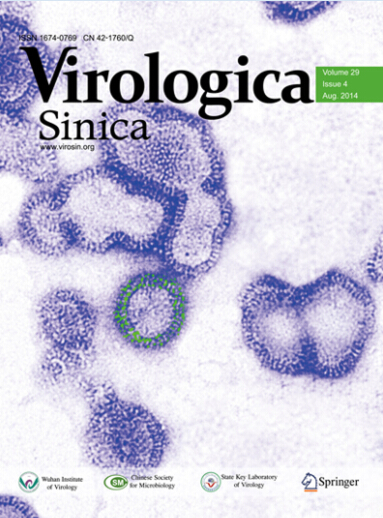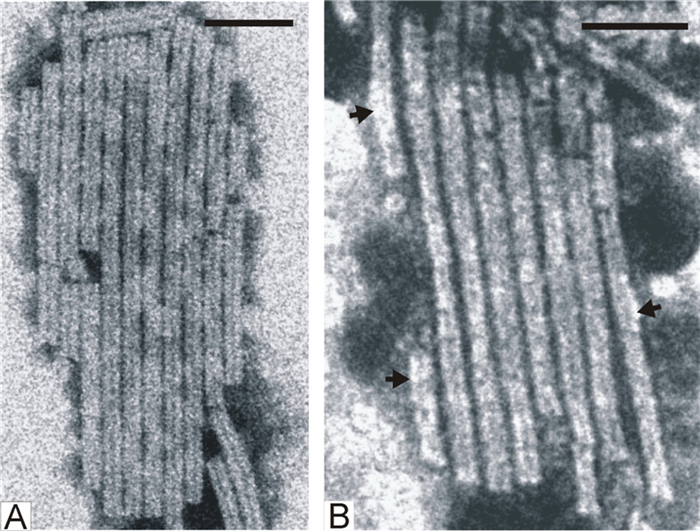-
Begam M, Narwal S, Roy S, Kumar S, Lodha M L, and KapoorH C. 2006. An antiviral protein having deoxyribonuclease and ribonuclease activity from leaves of the post-flowering stage of Celosia cristata. Biochemistry (Moscow), 71: 44-48.
doi: 10.1134/S0006297906130074
-
Choudhary N L, Yadav O P, Lodha M L. 2008. Ribonuclease, deoxyribonuclease, and antiviral activity of Escherichia coli expressed Bougainvillea xbuttiana antiviral protein. Biochemistry(Moscow), 73: 273-277.
doi: 10.1134/S000629790803005X
-
Davydova V N, Naberezhnykh G A, Yermak I M, Gorbach V I, Solov'eva T F. 2000. Comparative study of physicochemical properties of chitosans of varying degree of polymerization in neutral aqueous solutions. Biofizika, 45: 641-647. (In Russian)
-
Davydova V N, Nagorskaya V P, Gorbach V I, Kalitnik A A, Reunov A V, Solov'eva T F, Yermak I M. 2011. Chitosan antiviral activity: Dependence on structure and depolymerisation method. Appl Biochem Microbiol, 47: 103-108.
doi: 10.1134/S0003683811010042
-
Edreva A. 2004. A novel strategy for plant protection: Induced resistance. J Cell Molec Biol, 3: 61-69.
-
Esau K. 1968. Viruses in plant hosts. Form, distribution and pathologic effects. Madison, Milwaukee, and London: Univ.Wisconsin Press, p225.
-
Everitt E, Persson M J, Wohlfart C. 1988. pH-dependent exposure of endoproteolytic cleavage sites of the adenovirus 2 hexon protein.FEMS Microbiol Lett, 49: 229-233.
doi: 10.1111/j.1574-6968.1988.tb02721.x
-
Golinowski W, Kupidlowska E, Skrzeczkowski L. 1981.Degradation of potato virus X (PVX) in the intercellular spaces of potato mesophyll. Phytopathol Z, 101: 136-142.
-
Hadrami A E, Adam L R, Hadrami I E, Daayf F. 2010. Chitosanin plant protection. Mar Drugs, 8: 968-987.
doi: 10.3390/md8040968
-
Hatsugai N, Kuroyanagi M, Yamada K, Meshi T, Tsuda S, KondoM, Nishimura M, Hara-Nishimura I. 2004. A plant vacuolar protease, VPE, mediated virus-induced hypersensitive cell death. Science, 305: 855-858.
doi: 10.1126/science.1099859
-
Iriti M, Sironib M, Gomarasca S, Casazza A P, C. Soave C, Faoro F. 2006. Cell death-mediated antiviral effect of chitosan in tobacco. Plant Physiol Biochem, 44: 893-900
doi: 10.1016/j.plaphy.2006.10.009
-
Kulikov S N, Chirkov S N, Il'ina A V, Lopatin S A, Varlamov V P.2006. Effect of the molecular weight of chitosan on its antiviral activity in plants. Appl Biochem Microbiol, 42: 200-203.
doi: 10.1134/S0003683806020165
-
Lapshina L A, Reunov A V, Nagorskaya V P, Zvyagintseva T N, Shevchenko N M. 2006. Inhibitory effect of fucoidan from alga Fucus evanescens on the spread of infection induced by tobacco mosaic virus in tobacco leaves of two cultivars. J PlantPhysiol, 53: 246-251.
doi: 10.1134/S1021443706020154
-
Lapshina L A, Nagorskaya V P, Reunov A V, Barabanova A O, Shevchenko N M, Yermak I M, Zvyagintseva T N, Elyakova LA. 2011. Correlation between influence of polysaccharides on hydrolase activity and their antiviral effect in tobacco leaves. Biochemistry (Moscow), 76: 566-572.
-
Mayhew D E, Ford R E. 1971. An inhibitor of tobacco mosaic virus produced by Physarum potycephalum. Phytopathology, 61:636-640.
doi: 10.1094/Phyto-61-636
-
Otsuki Y, Takebe I, Onho T, Fukuda M, Okada Y. 1977.Reconstitution of tobacco mosaic rods occurs bidirectionally from an internal initiation region: demonstration by electron microscopic serology. Proc Natl Acad Sci USA, 74: 1913-1917.
doi: 10.1073/pnas.74.5.1913
-
Park C J, Kim K J, Shin R, Park J M, Shin Y C, Paek K H. 2004.Pathogenesis-related protein 10 isolated from hot pepper functions as a ribonuclease in an antiviral pathway. Plant J, 37: 186-198.
doi: 10.1046/j.1365-313X.2003.01951.x
-
Reunov A V, Lapshina L A, Nagorskaya V P, Elyakova L A. 1996.Effect of 1, 3;1, 6-β-glucan on infection of detached tobacco leaves with tobacco mosaic virus. J Phytopathol, 144: 247-249.
doi: 10.1111/j.1439-0434.1996.tb01524.x
-
Reunov A V, Lapshina L A, Nagorskaya V P. 2013. Comparative study of accumulation of two Potato virus X strains differing in virulence, hydrolase activity and morphological abnormalities in Datura stramonium L. leaves. J Phytopathol, 161: 348-352.
doi: 10.1111/jph.12073
-
Reunov A V, Nagorskaya V P, Lapshina L A, Yermak I M, Barabanova A O. 2004. Effect of k/β-carragenan from red alga Tichocarpus crinitus (Tichocarpaceae) on infection of detached tobacco leaves with tobacco mosaic virus. J Plant Dis Protect, 111: 165-172.
doi: 10.1007/BF03356143
-
Reunov A V, Lapshina L A, Nagorskaya V P, Zvyagintseva T N, Shevchenko N M. 2009. Effect of fucoidan from the brown alga Fucus evanescens on the development of infection induced by potato virus X in Datura stramonium L. J Plant Dis Protect, 116: 49-54.
doi: 10.1007/BF03356285
-
Roggero P, Pennazio S. 1984. Quantitative determination by ELISA of tobacco necrosis virus from necrotic local lesions in tobacco. J Virol Methods, 8: 283-291.
doi: 10.1016/0166-0934(84)90065-X
-
Rouhier P, Kopp M, Begot V, Bruneteau M, Fritig B. 1995. Structural features of fungal β-D-glucans for the efficient inhibition of the initiation of virus infection on Nicotiana tabacum. Phytochemistry, 39: 57–62..
doi: 10.1016/0031-9422(94)00852-K
-
Salomon R. 1989. Partial cleavage of sweet potato feathery mottle virus coat protein subunit by an enzyme in extracts of infected symptomless leaves. J Gen Virol, 70 : 1943-1949.
doi: 10.1099/0022-1317-70-8-1943
-
Slováková L, Lišková D, Capek P, Kubašková M, Kákoniová D, Karácsonyi Š. 2000. Defence responses against TNV infection induced by galactoglucomannan-derived oligosaccharides in cucumber cells. Eur J Plant Pathol, 106: 543-553.
doi: 10.1023/A:1008722318178
-
Stübler D, Buchenauer H. 1996. Antiviral activity of the glucan lichenan (Poly-β-{1→3, 1→4}D-Anhydroglucose) 1. Biological activity in tobacco plants. J Phytopathol, 144: 37-43.
doi: 10.1111/j.1439-0434.1996.tb01486.x
-
Šubíková V, Slováková L, Farkaš V. 1994. Inhibition of tobacco necrosis virus infection by xyloglucan fragments. Z PflKrankh Pflschurz, 101: 128-131.
-
Thakur M, Sohal B S. 2013. Role of elicitors in inducing resistance in plants against pathogen infection: A Review. ISRN Biochemistry, doi.org/10.1155/2013/762412.
doi: 10.1155/2013/762412
-
Trifonova E A, Sapotsky M V, Komarova M L, Scherban A V, Shumny V K, Polyakova A M, Lapshina L A, Kochetov A V, Malinovsky V I. 2007. Protection of transgenic tobacco plants expressing bovine pancreatic ribonuclease against tobacco mosaicvirus. Plant Cell Rep, 26: 1121-1126.
doi: 10.1007/s00299-006-0298-z
-
Zhang L, French R, Langenberg W G, Mitra A. 2001. Accumulation of barley stripe mosaic is significantly reduced in transgenic plants expressing a bacterial ribonuclease. Transgenic Res, 10:13-19.
doi: 10.1023/A:1008931706679












